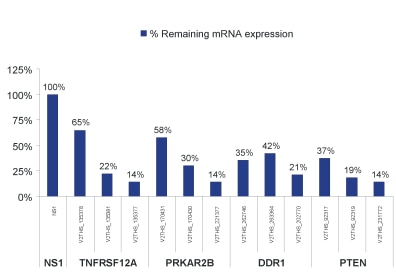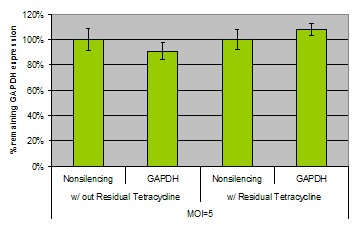TRIPZ Inducible Lentiviral shRNA
Inducible shRNA expression for regulatable gene silencing

TRIPZ Inducible Lentiviral shRNA
1Start Here
2Choose
TRIPZ Inducible Lentiviral shRNA combines the advantages of microRNA-adapted lentiviral vector design with Tet-inducibility to generate an RNAi trigger that permits reversible, controlled gene silencing. Conditional RNAi is especially useful when studying the function of essential genes, knockdown of which can be detrimental to the cell. The TRIPZ Lentiviral shRNA collection targeting the human genome was developed in collaboration with Greg Hannon (CSHL) and Steve Elledge (Harvard). The vector is engineered to be Tet-On® such that shRNA expression is induced in the presence of doxycycline.
Highlights
- Tet-inducible shRNA expression permits reversible and regulatable gene knockdown
- microRNA-adapted shRNA design enhances specificity and potency of silencing
- TurboRFP fluorescent reporter allows visual tracking of shRNA expression
- Lentiviral vector enables transductions of primary and non-dividing cells
Tet-On or Tet-Off configurations
The pre-designed TRIPZ shRNA collection is configured for expression of an shRNA in the presence of doxycycline (Tet-On configuration). However, it is possible to alter the construct such that expression occurs in the absence of doxycycline (Tet-Off configuration). The pTRIPZ vector can be easily converted to a Tet-Off configuration by Cre-loxP site-specific recombination or a standard restriction digest. The rtTA3 is flanked by loxP sites allowing in vitro or in vivo excision of the rtTA3 by exposure to Cre recombinase. The rtTA3 is also flanked by a pair of BamHI restriction sites allowing for straightforward cleavage and ligation of the vector to remove the rtTA3. Without the rtTA3 present, a tetracycline transactivator (tTA) can be added extraneously to the system allowing it to function as Tet- Off®; where expression of shRNA and TurboRFP are alternatively induced in the absence of doxycycline.
Individual shRNA constructs are shipped as glycerol stock cultures of E. coli in LB (low salt) broth with 8% glycerol, carbenicillin (100 µg/mL), and zeocin (25 µg/mL) ambient shipping. We check all cultures for growth prior to shipment.
The pre-designed TRIPZ shRNA collection is now expanded with over 10,000 additional unique constructs. TRIPZ shRNAs are available as bacterial glycerol stocks. Search for your gene(s) of interest to find and order
- Individual TRIPZ shRNA constructs
- TRIPZ Lentiviral shRNA Transfection Starter Kit, which includes up to three inducible TRIPZ shRNA as E. coli glycerol stock culture, positive and negative controls, plus DharmaFECT kb transfection reagent
- TRIPZ shRNA Packaging Starter Kit , which includes up to three inducible TRIPZ shRNA as E. coli glycerol stock culture, positive and negative controls, trans-lentiviral packaging mix, and a transfection reagent
- Target Gene Sets comprised of 3 to 6 TRIPZ shRNA constructs designed against a single gene
Footnotes
† When you purchase a minimum of three shRNA to the same target, at least one of the shRNA constructs will reduce target mRNA levels by 70% or more when used with Starter Kit protocols and normalized for delivery efficiency. Delivery conditions should be confirmed using appropriate positive controls provided in the kit and the percent-knockdown should be compared to cells using the negative control (non-targeting) shRNA.
Please note that the GIPZ Lentiviral shRNA and TRIPZ Inducible Lentiviral shRNA are not compatible with third generation packaging systems, such as ViraPower from Invitrogen. We recommend the Trans-Lentiviral Packaging System to general lentiviral particles for transduction of GIPZ and TRIPZ shRNA.
shRNA Controls
TRIPZ Inducible Lentiviral shRNA Controls
- Inducible shRNA positive and non-targeting negative controls are available as glycerol stock or viral particles.
pTRIPZ lentiviral vector

Figure 1 | Schematic diagram of pTRIPZ plasmid.

Knockdown induced by doxycycline
Figure 2 | High levels of knockdown achieved after induction with doxycycline. Knockdown of indicated target genes in HEK293T cells compared to a non-silencing control as determined by QPCR. Each bar represents an experimental duplicate while QPCR was performed triplicate using 18SrRNA as an internal reference. HEK293T cells were transduced at an MOI = 0.3, puromycin selected (5 µg/mL), and induced with doxycycline (1 µ/mL).
shRNA expression is not leaky in the absence of doxycycline

Figure 3 | Residual tetracycline in media does not result in leaky expression. The pTRIPZ vector does not express shRNA to GAPDH at levels capable of producing significant knockdown in the absence of doxycyline (whether in media with residual tetracycline or in special tetracycline free media).
Each bar represents four tissue culture replicates, all triplicated in QPCR for a total of 12 data points each. Statistical analysis was performed, and no statistically significant differences were found between non-targeting and GAPDH shRNA samples. Transduction at an MOI = 5 was performed in HEK293T cells after which cells were selected with 2 µg/mL puromycin for 96 hrs.
- A. T. Das et al., Viral evolution as a tool to improve the tetracycline-regulated gene expression system. J. Bio. Chem. 279(18), 18776-18782 (30 April 2004).
Protocols
Safety data sheets
Selection guides
Technical manuals
Related Products
Critical to any gene silencing experiment, RNAi controls enable accurate interpretation for reliable results.
Genome-scale TRIPZ Inducible Lentiviral shRNA library arrayed in 96-well plates.
Package 2nd or 3rd generation viral vectors with high efficiency. Lentiviral packaging kits with calcium phosphate provide lower cost and higher-efficiency viral packaging along with premium biosafety.
